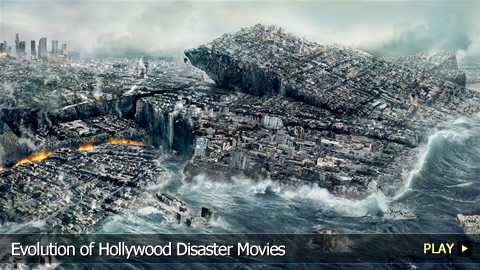The Evolution of Hollywood Disaster Movies

Forces of Nature, Asteroids and Aliens. Welcome to Watchmojo.com, and today we’ll be taking a look at the evolution of the disaster film genre, and our fascination with seeing the world end while we eat popcorn.
Disaster stories are as old as the Bible. And many have been produced since early cinema. But in the 1970’s, the genre evolved. Disaster films became a box office craze, carried by extraordinary budgets, special effects and the involvement of Hollywood’s biggest talent.
During the 70s, disaster movies shifted from always being set on a particular means of transportation (Poseidon Adventure) or in an individual building, such as presented in “The Towering Inferno”. The notion of an entire city experiencing a catastrophe materialized in the 1974 film “Earthquake”, which starred Charleton Heston. Its overwhelming success guaranteed that audiences would be hammered for the following decade with countless disaster films of all varieties from several competing studios.
Hollywood oversaturated the genre until box office bombs, such as 1978's "The Swarm" featuring Michael Caine became the norm. As public interest faded, studios became convinced that the real disasters they produced were the financial bombs being financed.
After a long break from the genre, the 90s saw the disaster movie genre re-emerge, this time due to the arrival of computer-generated graphics, which largely replaced practical effects. 1996’s “Independence Day” shook audiences with its unparalleled on-screen effects and mayhem. The film illustrated a possible alien extermination of mankind, and thrilled audiences with Will Smith’s cool on screen presence and one-liners.
This triumph at the box office jump-started an all-new studio race to produce the greatest on-screen disaster. The following summers were filled with double doses of similar disasters by competing studios. In 1997, 20th Century Fox released “Volcano”, while Universal Pictures fought back with “Dante’s Peak” as they each sought to capitalize on the public’s rekindled love of large scale special effects driven disasters.
The following summer audiences were again given two slices of the same pie when “Armageddon” and “Deep Impact” arrived on the silver screen. Both films boasted star studded casts and budgets bigger then the asteroids shown on screen.
In 2003, audiences got to see a group of scientists attempt to save Earth while tremors shook the globe in “The Core”. And 2004’s “The Day After Tomorrow” capitalized on our fears of global warming.
In 2009, audiences were presented with the film “Knowing”, which capitalized on the idea that disasters have been predicted and may be avoided. This notion appeared again in the Roland Emmerich film “2012”, which depicted the Myan world ending prediction of several simultaneous disasters in such an extreme manner, that it has been labeled ‘The Ultimate Disaster Movie.’
